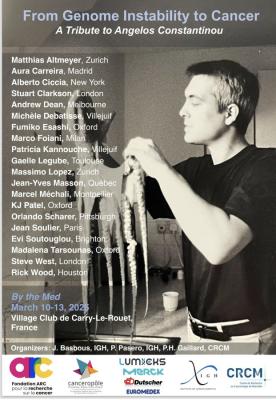To mitigate the threat of DNA double strand breaks (DSBs), human cells rely on the activity of multiple DNA repair machineries, which are tightly regulated throughout the cell cycle. In G1-phase, DSBs are mainly repaired by non-homologous end joining (NHEJ), whereas in S-phase, when the cell duplicates its genome to get prepared for mitosis, DSBs are repaired by homologous recombination (HR). The Breast CAncer type 2 protein (BRCA2) is a central regulator of HR in most eukaryotes. During HR, BRCA2 delivers the recombinases – RADiation sensitive 51 (RAD51) and Disrupted Meiotic cDNA 1 (DMC1) – at the DNA repair site. Human BRCA2 is large and mostly disordered, it is mutated in several cancers (1). The impact of the mutations in BRCA2 disordered regions is mostly unclear.
Whereas several teams described how BRCA2 disordered regions interact with PALB2 and the recombinase RAD51 during HR in somatic cells, we have identified novel BRCA2 interactions that contribute either to the repair or programmed DSB in meiosis or to the correct attachment of microtubules to kinetochores in mitosis. Indeed, during meiotic HR, the recombinogenic filament selectively invades the homologous chromosome and the resulting D-loop is stabilized, in order to favor the reciprocal exchange of homologous chromosome arms. Together with the teams of R. Kanaar and W. Baarends (Erasmus Medical Center, Rotterdam), we identified a BRCA2 region that specifically disrupts BRCA2 function in meiosis. We found that this region interacts with two proteins expressed in germinal cells: the mediator HSF2BP and the recombinase DMC1. I will describe how a small 51-aa fragment of BRCA2 triggers HSF2BP oligomerization into a 900 kDa complex that regulates BRCA2 degradation (2,3), and how another even smaller 20-aa fragment of BRCA2 stabilizes the DMC1-ssDNA filament (4). Together with the teams of A. Carreira (CBM Madrid) and A. Constantinou (IGH Montpellier), we identified a BRCA2 region which is specifically phosphorylated by PLK1 in mitosis and binds to both PLK1 itself (5) and the microtubule depolymerase KIF2C (6). I will show how BRCA2 phosphorylation regulates binding to these partners, and how KIF2C assembles into nuclear condensates that concentrate PLK1 and phosphorylated BRCA2 at the kinetochore microtubules in mitosis.



